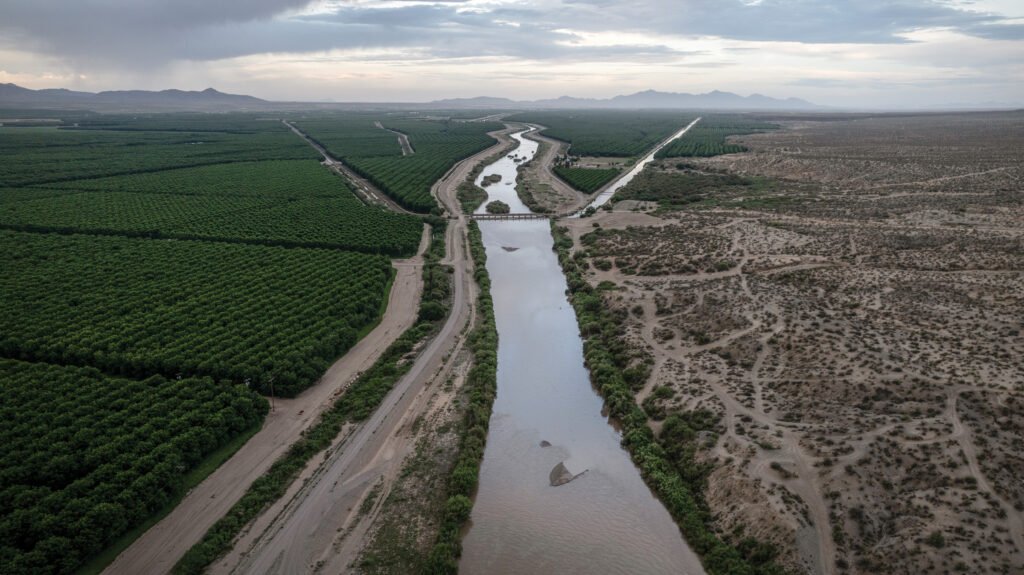Unraveling the Pecan Dilemma in Southern New Mexico’s Mesilla Valley
Nestled in the heart of the Chihuahua Desert, Southern New Mexico boasts unexpected greenery, primarily in the form of pecan orchards. This verdant transformation began over a century ago when the pecan tree (Carya illinoinensis), native to the lower Mississippi Valley, was first introduced to the arid Mesilla Valley. With only about 9 inches of rainfall annually, sustaining these Eastern hardwoods seemed a daunting challenge until the Rio Grande Project and its signature Elephant Butte Dam were completed in 1916, providing essential irrigation.
The Pecans of the Mesilla Valley
Stretching along the I-25 corridor between Truth or Consequences and the Texas border, more than 50,000 acres of pecan trees thrive in the region. The robust irrigation network constructed as part of the Rio Grande Project marked a remarkable agricultural shift, eventually leading New Mexico to surpass Georgia as the nation’s leading pecan producer by 2018.
A Historical Perspective
Initially, pecan planting in the Mesilla Valley was meager as the harsh climatic conditions posed significant challenges. However, with new irrigation infrastructure in place, the pecans began to flourish and became economically significant. Notably, the Stahmann family, who have farmed pecans since 1932, currently manages around 3,200 acres, exemplifying the region’s agricultural wealth.
Water: The Lifeblood of Pecans
Despite the apparent prosperity brought by pecan farming, sustaining these trees comes at a considerable ecological cost. Each mature pecan tree can demand approximately 30,000 gallons of water annually, leading New Mexico pecan farmers to utilize an estimated 93 billion gallons of water per year. This substantial water consumption has raised concerns, particularly as the region grapples with a 25-year drought, resulting in the Rio Grande running completely dry for nine months last year.
Consider the implications of this on the river, which serves about 13 million people across three states, delivering water to urban populations and irrigating vast expanses of farmland. Historically, the Rio Grande supported small-scale agriculture through the acequia systems established by Spanish settlers. Today, the river’s flow is heavily regulated, with legal disputes between Texas and New Mexico regarding water obligations complicating the situation further.
The Effects of Drought
The continuous drought has not only compromised agricultural sustainability but also exacerbated legal tensions over water rights. As pecan growers pump the groundwater at unsustainable rates, the ecological landscape is rapidly changing. Fish species like the shovelnose sturgeon and the Rio Grande shiner have become scarce, and many riparian habitats are now diminished.
Alternatives to Pecan Farming
In light of diminishing resources, some farmers are exploring alternative crops that require less water than pecans. For example, pistachios are gaining attention for their ability to thrive in arid climates while having a diminished water footprint. Other farmers, like Ryan Duran from Big Moon Farms, focus on cultivating seasonal crops that are consumed locally, tapping into community needs rather than commercial profits.
Restoration Efforts and Ecological Balance
Efforts are underway to revitalize the Rio Grande and restore its critical ecologies. Initiatives like the Leasburg Extension Lateral Wasteway #8 Restoration project aim to reintroduce native flora, enhancing biodiversity and ameliorating water storage capacity in the region. Such projects could play a pivotal role in adapting to changing climate conditions, mitigating flood impacts, and supporting local wildlife.
The Way Forward
As the climate crisis deepens, innovative solutions are crucial. Water management strategies that prioritize both agricultural needs and ecological health are essential. By implementing practices that mimic historical water flows and promoting biodiversity, stakeholders can start to rebalance the relationship between agriculture and natural ecosystems.
Though challenges remain, farmers like Rafael Rovirosa recognize the urgency of diversifying crops and experimenting with more sustainable agriculture practices. His explorations into growing value-added crops, such as Spanish oak and Italian pine, could yield economic rewards while managing water usage more effectively.
Conclusion
The pecan orchards of Southern New Mexico tell a story of agricultural ambition, ecological cost, and the need for sustainable practices. As farmers navigate the uncertain terrain of climate challenges, the future of not just pecans but also the Rio Grande and its inhabitants hangs in the balance.
For more in-depth information on irrigation practices and agricultural sustainability, check out resources from the New Mexico Office of the State Engineer and Food and Water Watch.


